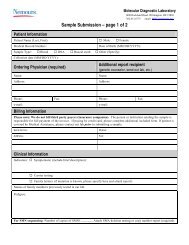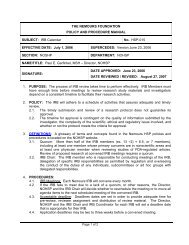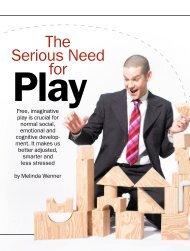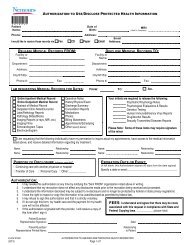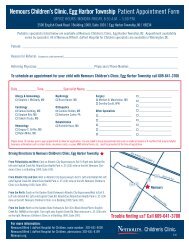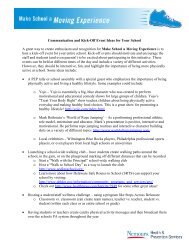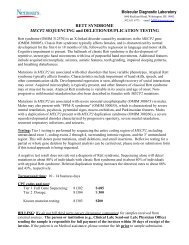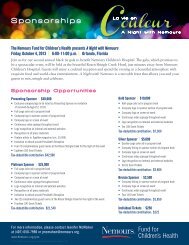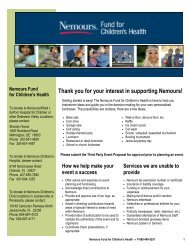Best Practices for Healthy Eating Guide - Nemours
Best Practices for Healthy Eating Guide - Nemours
Best Practices for Healthy Eating Guide - Nemours
You also want an ePaper? Increase the reach of your titles
YUMPU automatically turns print PDFs into web optimized ePapers that Google loves.
Family-Style Meals<br />
Using family-style dining in your early care and education<br />
program supports independence, social skills, healthy<br />
eating and more. Children who are given the opportunity<br />
to actively participate in mealtime learn and practice<br />
important skills like passing and serving food and drinks,<br />
table manners, preparing <strong>for</strong> meals and cleaning up. They<br />
are encouraged to try new foods and to serve themselves<br />
appropriate portions. Use the below guidance to plan <strong>for</strong><br />
family-style dining in your program.<br />
Mealtime Routine Sample<br />
1. Call <strong>for</strong> helpers — children with daily jobs<br />
2. Transition activity — song<br />
3. Bathroom and hand wash break<br />
4. Children sit at the table as the food is placed on the table<br />
5. Teachers sit and eat with children<br />
6. Children and teachers clean up<br />
7. Transition — children choose quiet books or puzzles<br />
as others finish eating<br />
Family-Style Mealtime Checklist<br />
Mealtime routine<br />
Teachers’ routines allow <strong>for</strong> food to be prepared and<br />
ready at the designated mealtime.<br />
Appropriately sized bowls and serving utensils<br />
Food is served in bowls of appropriate size that<br />
children can lift and pass.<br />
Serving bowls are of appropriate material so they do<br />
not conduct heat and are not too hot to pass.<br />
Small size scoops, one-piece plastic tongs, and<br />
short-handled hard plastic serving spoons are used.<br />
Serving utensils should align with serving size<br />
recommendations <strong>for</strong> age and food group.<br />
Mealtime expectations to review with children<br />
We eat together at the table.<br />
We all come to the table at the same time.<br />
We wait until everyone is ready be<strong>for</strong>e we begin<br />
our meal.<br />
We serve ourselves and pass food to each other.<br />
We use inside voices.<br />
Passing food practice <strong>for</strong> children<br />
Pass with both hands.<br />
Keep food over the table when passing it.<br />
Hold the bowl by the side to keep fingers out of food.<br />
Serving utensils practice <strong>for</strong> children:<br />
try this <strong>for</strong> a small group activity or set up a learning<br />
center in classroom<br />
Practice with scoops, tongs, and short-handled hard<br />
plastic serving spoons.<br />
Pouring practice <strong>for</strong> children:<br />
set up water table or learning center <strong>for</strong> practice<br />
in classroom<br />
Pretend practice.<br />
Practice with dry liquid such as sand or beans.<br />
Practice with water.<br />
Practice with water and pouring into child-size cups.<br />
Cleanup practice <strong>for</strong> children:<br />
try this in dramatic play or as a small group activity<br />
Pretend cleanup with sponge or cloth.<br />
Pretend floor cleanup with mini-mop or cloth.<br />
Practice cleanup of table and floor with water.<br />
National Food Service Management Institute. (2011). Happy mealtimes <strong>for</strong> healthy kids. University, MS: Author.<br />
<strong>Best</strong> <strong>Practices</strong> <strong>for</strong> <strong>Healthy</strong> <strong>Eating</strong> 31



